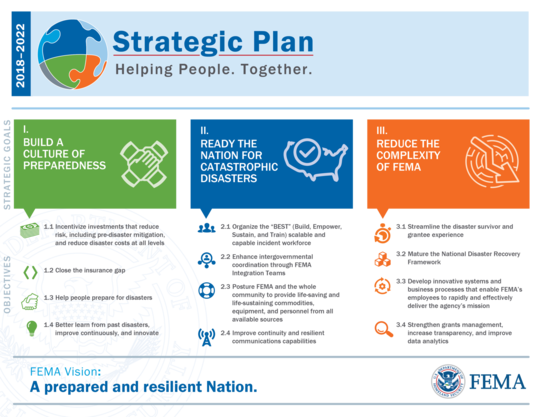FEMA's Strategic Plan sets out three overarching strategic goals:
 The 2018-2022 Strategic Plan creates a shared vision for the field of emergency management and sets an ambitious, yet achievable, path forward to unify and further professionalize emergency management across the country. We invite all of our stakeholders and partners to also adopt these priorities and join us in building a stronger Agency and a more prepared and resilient Nation. Learn more at https://www.fema.gov/strategic-plan.
WHAT: FEMA 2018-2022
Strategic Plan Webinar
WHO: David Bibo, FEMA
Associate Administrator for Policy, Program Analysis, and International Affairs
(Acting)
WHEN: Tuesday, March 27,
2018 at 1:00 PM EDT or Wednesday,
March 28, 2018 at 3:30 PM EDT
PARTICIPANT INFORMATION:
For Tuesday
Test your Adobe Connect connection prior to the meeting by clicking here.
Closed captioning: http://www.fedrcc.us//Enter.aspx?EventID=3583747&CustomerID=321
For Wednesday
-
Via Phone: Dial in: 323-794-2558
- Participant passcode: 117003
Test your Adobe Connect
connection prior to the meeting by clicking here.
Closed captioning: http://www.fedrcc.us//Enter.aspx?EventID=3583751&CustomerID=321
For the March 27th
webinar please RSVP here. For the March 28th webinar, please RSVP here.
1. Build a Culture of Preparedness
Youth from the South Los Angeles area engage in a Community Emergency Response Team exercise. In partnership with the DHS Center for Faith-based & Neighborhood Partnerships, the Los Angeles Fire Department and Los Angeles County Public Health division have been able to reach a diverse group of youth to introduce disaster preparedness to build positive relationships with local first responders and increase public safety.
Every segment of our society, from individual to government, industry to philanthropy, must be encouraged and empowered with the information it needs to prepare for the inevitable impacts of future disasters. Three ways to get involved in building a culture of preparedness are:
- Strengthen the financial preparedness of your household and/or organization
- Learn what to do when You Are the Help Until Help Arrives
- Increase the safety and security of your house of worship
2. Ready the Nation for Catastrophic Disasters
The Hackleburg Methodist Church (Hackleburg, AL) serves as disaster relief center for tornado survivors. Volunteers from Kansas and Wisconsin have come to help run the center. The National Voluntary Organizations Active in Disaster (www.nvoad.org), faith-based organizations and other groups are an intregal part of the recovery process after disasters.
FEMA will work with its partners across all levels of government to strengthen partnerships and access new sources of scalable capabilities to quickly meet the needs of overwhelming incidents. Visit FEMA's Voluntary, Faith-Based, & Community-Based Organizations webpage to learn more about how you can get involved.
3. Reduce the Complexity of FEMA
Sources of Financial Help After a Disaster provides an overview of resources available to disaster survivors, including voluntary agencies, insurance, FEMA assistance, and/or a disaster loan from the Small Business Administration. Learn more about disaster assistance at www.disasterassistance.gov.
FEMA must continue to be responsible stewards of the resources we are entrusted to administer. We must also do everything that we can to leverage data to drive decision-making, and reduce the administrative and bureaucratic burdens that impede impacted individuals and communities from quickly receiving the assistance they need.
To submit general questions, comments, or feedback regarding the 2018-2022 FEMA Strategic Plan, please contact FEMA-Strategic-Planning@fema.dhs.gov.
FEMA RELEASES CONTINUITY
GUIDANCE CIRCULAR
The Federal Emergency Management Agency
(FEMA) released the Continuity Guidance Circular (CGC)
following a
nationwide, whole community effort to review and revise the guidance. The
CGC guides efforts to develop and
maintain the capability to ensure continuity of operations, continuity of government, and enduring
constitutional government during an emergency that disrupts normal operations. Development and maintenance of continuity
capabilities helps build and sustain a more resilient nation that is equipped
to sustain essential functions and core capabilities and deliver critical
services under all conditions.
The CGC describes federal and non-federal
continuity efforts; outlines whole community continuity roles,
responsibilities, and coordinating structures; and describes the process for
building and maintaining capabilities to ensure the performance of essential
functions and delivery of critical services and core capabilities.
Organizations and governments at all
levels can draw upon the CGC as a reference when creating or revising
continuity plans, programs, and processes.
Many jurisdictions and organizations already have an existing continuity
program and plan, and will use the Circular to refine capabilities and
processes.
To read the
Continuity Guidance Circular and obtain additional information, visit www.fema.gov/continuity-guidance-circular.
Additional inquiries can be directed to FEMA-CGC@fema.dhs.gov.
FEMA offers training, technical assistance, and outreach to assist
organizations and governments develop and maintain a continuity plan and
program and implement the concepts found within the CGC. The Continuity Resource Toolkit, found
at www.fema.gov/continuity-resource-toolkit,
contains these additional tools, templates, and resources.
DHS Center for Faith-Based & Neighborhood Partnerships
 |
|
The DHS Center for Faith-Based and Neighborhood Partnerships was created in 2006 by an executive order to help emergency managers effectively engage with faith and community-based groups. The DHS Center carries out the policies and program priorities of the White House Office of Faith-Based & Neighborhood Partnerships, the Department of Homeland Security (DHS), and the Federal Emergency Management Agency (FEMA). |
Have a comment, question or looking for information? E-mail us at Partnerships@fema.dhs.gov
|